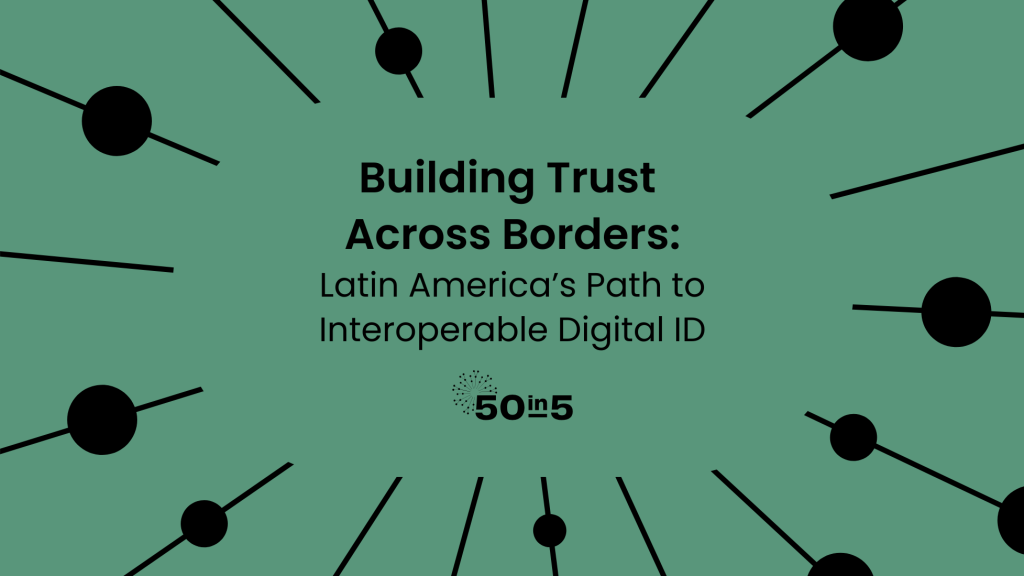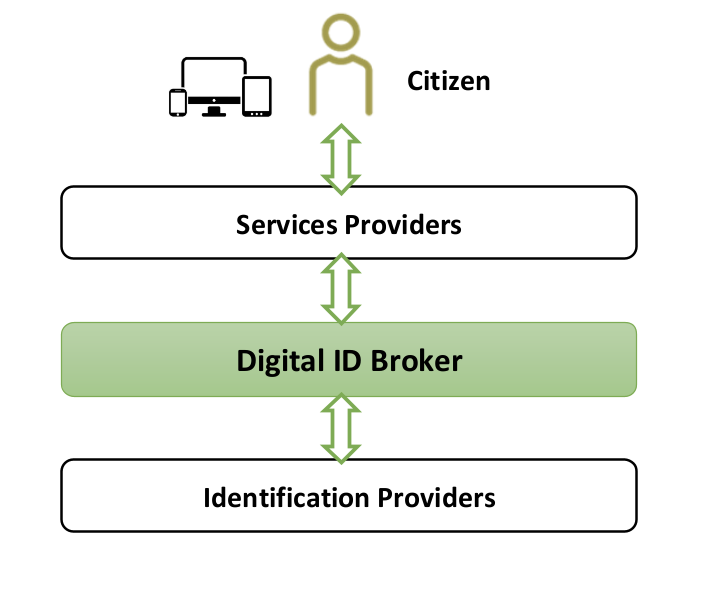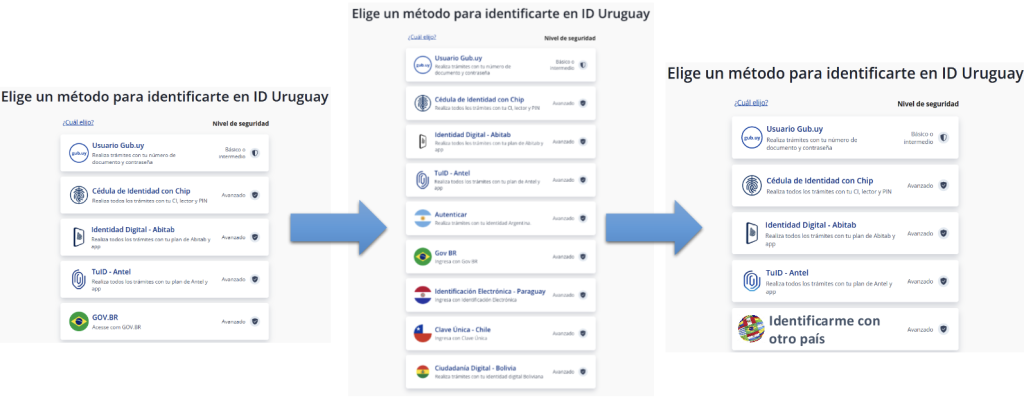Building Trust Across Borders: Latin America’s Path to Interoperable Digital ID

Author: Juan Pablo García Cairello, Digital Identity Manager at AGESIC, Uruguay
For years, organisations around the world have been working together to advance digital transformation by accelerating the development of digital public infrastructure (DPI). A country’s level of DPI maturity directly shapes societal outcomes—enabling fairer access to essential services, greater efficiency and transparency, and more inclusive and sustainable economic growth.
The 50-in-5 campaign reflects this momentum, bringing together countries committed to working together to implement secure, inclusive, and interoperable DPI. Uruguay is one of the countries demonstrating how fundamental systems can be designed based on a digital government “building block” model, where digital ID is a critical component. Starting with a national digital ID ecosystem, based on pilot experiences with its neighbors Brazil and Argentina, a cross-border digital ID model was designed, based on global standards and using a component called “digital ID broker” to standardise cross-border integration.
A New Imperative: Connecting Digital and Physical Identity
The COVID-19 pandemic exposed critical gaps in digital access, especially for individuals outside of Uruguay—such as foreign property or business owners—who were unable to access services remotely. Without a trusted Uruguayan digital ID or a way to verify their identity, these individuals were effectively excluded from digital services. This highlighted the need to align digital IDs with physical identification documents, enabling trusted foreign IDs to be used within Uruguay’s digital ecosystem.
This vision is based on the idea that digital IDs should behave just like physical ones, meaning that a person obtains a reliable digital ID in their home country and should be able to use it in other countries, just as national ID cards or passports do.
The Uruguayan Digital ID Ecosystem
The use of digital IDs is increasingly similar to how we use physical ones. For decades, we have relied on physical documents (national ID cards, passports, etc.) issued by trusted authorities and recognised in both the public and private sectors. Today, the digital world is moving in a similar direction. Online services integrate with identity providers, and credential centers, such as Apple or Google, serve as digital intermediaries for authentication, simplifying the user experience and reducing risks.
Some countries are consolidating these advances into unified “single account” systems. Inspired by EU frameworks (eIDAS, ETSI) and NIST 800-63, Uruguay and Brazil have made notable progress, giving rise to digital ID brokers, such as ID Uruguay, that act as intermediaries between services and authorised identity providers.
A digital ID broker integrates different identity services tailored and standardised for its ecosystem. This enables the transition from a single digital identity system (e.g., a single account) to a national ecosystem, where users can choose one of the integrated providers and use it to easily and reliably identify themselves digitally throughout the ecosystem. This model delegates authentication to trusted providers, ensuring identity consistency across the ecosystem, like traditional physical IDs.
The following image shows this ecosystem in simplified form:

ID Uruguay has grown rapidly: from 6 million digital authentications in 2021 to 17 million in 2024. Four regulated digital ID providers currently operate in the Uruguayan ecosystem, overseen by the Electronic Certification Unit (UCE), which defines three levels of trust:
- Basic: Online registration without identity verification. Authentication is via username and strong password.
- Intermediate: Identity verified using approved methods (e.g., biometrics, digital signature). Includes two-factor authentication.
- Advanced: In-person registration with biometric validation. Uses a digital certificate with an advanced electronic signature, equivalent to in-person identity verification.
Currently, more than 190 services, both government and public platforms, are integrated with ID Uruguay. More than 100,000 authentications are performed on a typical business day, and usage of the Advanced level exceeds the Basic level. This shift indicates growing public trust in digital ID.
Pioneering Regional Integration
As Latin America and the Caribbean expand their digital ecosystems, the need for regional interoperability becomes a priority. In collaboration with the Latin American and Caribbean e-Government Network (GEALC Network), Uruguay began testing cross-border integration in 2023, linking ID Uruguay with Argentina’s digital ID broker, Autenticar, to assess compatibility.
The goal was clear: to allow citizens with secure IDs in one country to access services in another. Achieving this required committed cooperation, close dialogue, and a willingness to experiment. A key concept was treating each national broker as a network of federated trusted identity providers, allowing them to recognise each other. Autenticar also adapted Argentina’s local identity data to align with the shared cross-border framework, an essential step in overcoming the system gaps necessary for interoperability.
Building on this experience, Uruguay began working with Brazil. Integration was accelerated thanks to Gov.br‘s alignment with the standards and protocols implemented in ID Uruguay. This culminated in October 2024 with the first production-level cross-border digital identity implementation in Latin America. Through this integration, Brazilian citizens will be able to access 40 Uruguayan services, such as certificates for the transport of yerba mate and URSEA, using their trusted GOV.br credentials, just as they have long done with physical ID documents such as passports.
A model for cross-border digital identification
The experiences with Argentina and Brazil confirmed the importance of digital ID brokers in facilitating standardised cross-border interoperability, one of the fundamental pillars of DPI. The process has also helped refine the standards necessary for future integrations, creating a model that other countries in the region can follow more efficiently.
Beyond cross-border authentication, digital ID brokers offer multiple national benefits:
- They enable the operation of multiple public and private identity providers, fostering innovation and greater coverage nationwide, narrowing gaps, and achieving greater access to individuals.
- They strengthen cybersecurity through the centralisation and standardisation of identification. All security controls implemented at the broker impact all digital IDs (authentications) nationwide.
- They generate reliable data for policymaking and the use of open data, since all authentications go through the broker.
- It acts as an intermediary between national and international systems, enabling secure data transformation.
- It supports next-generation identity technologies, such as decentralised and verifiable credentials (for example, through OIDC4VC). As new identification methods emerge, they can be integrated with the broker once and automatically made available to the entire ecosystem.
In addition to developing a country-level digital ID ecosystem as a key component of building block architecture, the broker also facilitates and standardises cross-border digital ID. With a single integration (with a broker from another country), it simply enables all ID providers to use the other country’s digital services. Additionally, the broker can develop specific controls for cross-border IDs, as well as perform checks and data conversions if necessary to establish a dialogue with the other country, separating the national ecosystem from the international one.
Scaling secure and standardised cross-border digital ID across the region
Many countries expressed interest in developing a digital ID broker, so the GEALC Network proposed developing a model broker that would constitute a digital public good and could be implemented by each country. This would develop a digital ID ecosystem in each country but also generate a standardised layer that facilitates cross-border integration.
The initiative was supported from the outset by the GEALC Network, the Inter-American Development Bank (IDB), and the Organization of American States (OAS). At the end of 2024, the World Bank and Co-develop joined the GEALC Network with technical support and financing to develop a model digital ID broker for the region.
At the beginning of 2025, other organisations involved in DPI development on various continents began to show interest and support in the project. Among them, 50-in-5, CDPI, and the Digital Public Goods Alliance, carrying out various activities that are helping to validate and exchange knowledge and experiences on the topic, among other relevant contributions.
The model broker is currently being developed, and in parallel, a working group was formed with several countries in the region to prepare the ground in each country for the broker’s implementation. Some countries are developing their identification providers, others are preparing them for integration into the broker, while many others are taking the first steps.
The main short-term challenges are:
- Develop a minimum viable product (MVP) for the first implementations, including regulatory, technical, and governance frameworks in each country.
- Identify relevant cross-border use cases, such as trade, tax, immigration, and tourism, to demonstrate their practical value.
- The MVP is expected to be implemented in at least three or four countries by the end of the year, also integrating ID Uruguay and Gov.br.
Most significant achievements to date:
- A model was developed and validated to develop standardised and reliable forms of cross-border digital IDs in the region.
- Requirements, protocols, standards, criteria, and data sets were defined to identify people in detail for the model.
- In addition to Uruguay and Brazil, many countries are actively participating in the definition, design, and development of the model broker and preparing their organisations to implement it: Argentina, Chile, Colombia, Costa Rica, Ecuador, Guatemala, Paraguay, the Dominican Republic, among others.
- The most important achievement: In the context of the GEALCl Network, relevant organisations with extensive capabilities such as the IDB, the World Bank, the OAS, and Co-Develop, as well as the DPI community, joined forces to support this initiative (making it entirely viable), and a broad, collaborative and highly active technical working group was formed with many countries in the region to advance the same vision.
Lessons for the Future
While obstacles remain, these early experiences offer important lessons:
- Collaboration—through joint testing, dialogue, and shared development—is essential to solving integration challenges. Definitions must be made in participatory working groups; all opinions contribute and are important.
- Technology must be at the service of people. Digital IDs must meet real needs and improve access.
- Public institutions and use cases play a key role in enabling cross-border services.
- Regional organisations such as the GEALC Network and its members are vital for coordination, trust-building, and momentum.
- Demonstrating real successes (such as the ID Uruguay–Gov.br integration) is more compelling than theoretical proposals.
- Beyond technology and standards, always keep in mind the goal: that people can use their trusted digital IDs from their country to easily and securely access a digital service in another country.
Together, these lessons lay the foundation for scalable and interoperable digital identification across the region, driving inclusion, security, and digital transformation for all.
Future Vision
By 2026, the goal is to continue evolving the model broker, expand its adoption throughout the region, and support the creation of robust and interoperable national digital ID ecosystems by design.
One of the most widely used methods, such as “username and password,” has been reinforced in various ways over the past few decades and is becoming obsolete. It is necessary to enable and encourage the use of modern, more secure, and easier-to-use digital IDs, based on the strengths offered by digital signatures, such as the use of verifiable credentials for authentication.
Several countries are making progress in verifiable credential ecosystems. The broker should incorporate the ability to authenticate using these methods soon. Another key advantage of the broker and of having a model that is a digital public good is that a single development is carried out and impacts all countries where the broker has implemented it. Once implemented in all countries, these methods will automatically become available to all integrated digital services in each country, substantially facilitating and optimising the widespread use of these modern, safer, and easier methods.
Another important challenge soon is registering the model broker as a DPG, which will facilitate adoption in any country globally, contribute to organising its governance, and maximise the investment being made by the members of the GEALC Network.
One more relevant aspect for the GEALC Network will be defining its governance. To ensure a more sustainable and scalable approach in Latin America and the Caribbean, the creation of a “broker hub” is proposed. Under this model, each country would integrate with the hub only once, streamlining technical integration and enabling mutual recognition of digital IDs. Discussion and exchange forums will be needed to determine the governance and architecture of the hub, and to assess whether a centralised or distributed model best suits regional needs.

The concept draws inspiration from the European Union’s “EU Login” system: when a user wants to access a service in another country, they are routed through a central hub to select their home country and then their national digital ID provider.
Impact
Looking ahead, the most important aspect of this entire plan is to achieve cross-border digital identification in Latin America and the Caribbean ensuring the desired impact. It is important to keep in mind that what we want to achieve is what has already been happening with traditional identification for decades but taking advantage of all the benefits offered by ICTs. Anyone from any country should be able to access a digital service from another country using their trusted digital identification from their country of origin. This simple act allows all digital services in the region to be provided remotely from other countries.
Sectors such as foreign trade, tourism, transportation, immigration, and tax administration would greatly facilitate access for foreigners in a secure and easy manner. At the same time, individuals could meet service needs abroad from their homes at minimal cost, in a simple and reliable way. While much remains to be done, the union of large, recognised organisations and, above all, distinguished professionals from different countries–bringing diverse visions and capabilities–helep streamlines and enrich the path toward sustainably advancing the “Digital Identification” pillar of digital public infrastructure in Latin America and the Caribbean.
Currently, there are 40 digital services available in Uruguay for secure identification in Brazil. The challenge, posed and embraced by the entire ecosystem, is to achieve thousands of services in numerous countries in the medium term.
Be part of the conversation shaping digital cooperation worldwide—sign up now to receive updates and watch the DPI Cooperation in Motion 50-in-5 Milestone Event live, taking place in the context of the 80th United Nations General Assembly.
